Silk taffeta, with its luxurious sheen and impeccable drape, invites the creation of exquisite garments and accessories.
This opulent fabric, prized for its smooth texture and ability to hold its shape, lends itself beautifully to a myriad of sewing projects.
From glamorous evening gowns and cocktail dresses that showcase their luminosity to voluminous ballgowns with dramatic silhouettes, silk taffeta elevates formalwear to new heights of elegance.
The versatility of this fabric extends to skirts, blouses, and cocktail attire, offering a sophisticated touch to casual and professional wardrobes.
Additionally, silk taffeta finds its way into accessories and home décor, providing an opportunity to infuse a sense of luxury into every facet of creative expression.
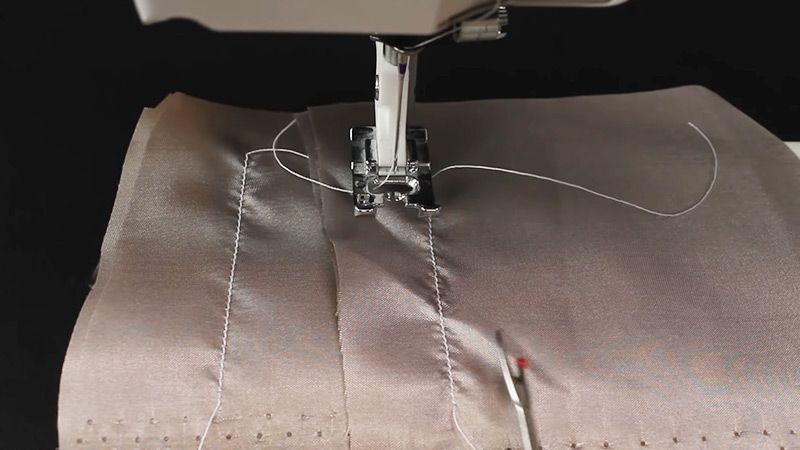
What Is Taffeta Fabric?
Taffeta is a smooth, crisp fabric characterized by its delicate, tightly woven structure, resulting in a glossy surface.
Typically made from silk, polyester, or a blend of fibers, taffeta’s unique weave creates a luxurious sheen and a distinctive rustling sound.
Known for its versatility, it can be soft or stiff, making it suitable for various garments, from elegant evening gowns to structured ballgowns.
Taffeta’s resilience to wrinkles and ability to hold its shape contribute to its popularity in formalwear and decorative applications, adding a touch of sophistication to various fashion and interior design projects.
What to Sew With Silk Taffeta?
Silk taffeta is a luxurious and versatile fabric prized for its smooth texture, crispness, and luminous sheen.
Regarding sewing with silk taffeta, there are numerous possibilities for creating elegant and sophisticated garments and accessories.
Here are some ideas on what to sew with silk taffeta:
Evening Gowns and Dresses
Silk taffeta’s enchanting qualities truly shine when crafting evening gowns and dresses. The fabric’s remarkable ability to hold its shape ensures that your garment will maintain its elegance throughout the night.
Consider creating floor-length gowns that gracefully cascade, capturing the light and highlighting the fabric’s inherent sheen.
Cocktail dresses in silk taffeta offer a perfect blend of sophistication and comfort, making them ideal for various formal events.
Additionally, A-line dresses made from this luxurious material showcase its structural beauty, emphasizing the fabric’s drape and its ability to create flattering silhouettes.
Ballgowns
The stiffness of silk taffeta elevates ballgowns to new heights of glamour. Picture a classic ballgown skirt billowing with grandeur, paired harmoniously with a fitted bodice to create a timeless and captivating look.
The inherent crispness of silk taffeta allows for the sculpting of dramatic silhouettes, making it the fabric of choice for those seeking a majestic presence at formal events.
Whether a traditional ball or a sophisticated gala, a silk taffeta ballgown ensures a show-stopping entrance.
Bridal Attire
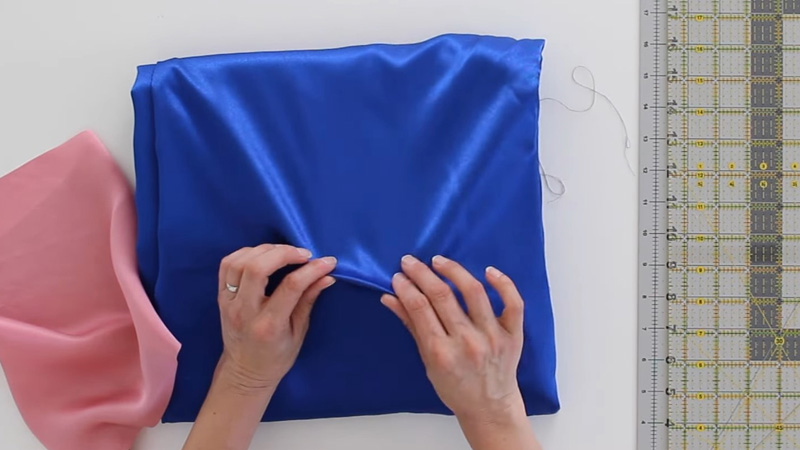
Silk taffeta is a beloved fabric in bridal fashion, offering brides a luxurious and timeless choice for their special day.
The fabric’s versatility allows for creating simple, sleek designs and more intricate, embellished styles. A silk taffeta wedding dress drapes beautifully, adding a touch of opulence to the bride’s silhouette.
The fabric’s natural sheen enhances the romantic aura, making it a cherished option for brides aiming to radiate sophistication and grace.
Skirts and Blouses
Introducing silk taffeta into everyday wear, consider sewing skirts or blouses for a versatile and sophisticated wardrobe.
A pencil skirt made from silk taffeta adds a touch of glamour to professional attire, seamlessly transitioning from the office to evening events.
With their crisp texture and lustrous finish, Taffeta blouses offer a timeless elegance that can elevate any outfit, whether paired with skirts, trousers, or even denim, for a more casual yet refined look.
Cocktail Attire
The crispness of silk taffeta lends itself perfectly to cocktail dresses and knee-length skirts, creating eye-catching and fashionable pieces.
Structural details such as pleating and gathers become focal points, adding flair and personality to the garment.
Shorter dresses in silk taffeta become a canvas for creative design, offering a perfect balance between sophistication and playfulness for various semi-formal occasions.
Accessories
Extend the luxurious feel of silk taffeta to accessories, enhancing your ensemble with scarves, shawls, and clutch purses.
The fabric’s glossy finish provides a touch of elegance, making these accessories perfect for formal events or statement pieces in everyday wear.
A silk taffeta accessory effortlessly elevates any outfit, ensuring you stand out with luxury.
Jackets and Coats
While not the warmest fabric, silk taffeta can be used to sew lightweight jackets or coats, particularly for special occasions.
A cropped taffeta jacket adds a layer of sophistication to evening outfits, providing warmth and a stylish silhouette.
The fabric’s ability to hold its structure ensures that the wearer exudes an air of refinement and luxury, even in outerwear.
Home Décor
Extend the allure of silk taffeta beyond personal attire by incorporating it into luxurious home décor items.
Curtains made from silk taffeta create a sumptuous and opulent atmosphere, allowing natural light to interact with the fabric’s glossy finish.
Throw pillows and tablecloths in silk taffeta become statement pieces, transforming living spaces with a touch of elegance and sophistication.
These home décor items provide an exquisite way to infuse a sense of luxury into your living space.
How to Sew With Silk? Some Tips and Guidelines
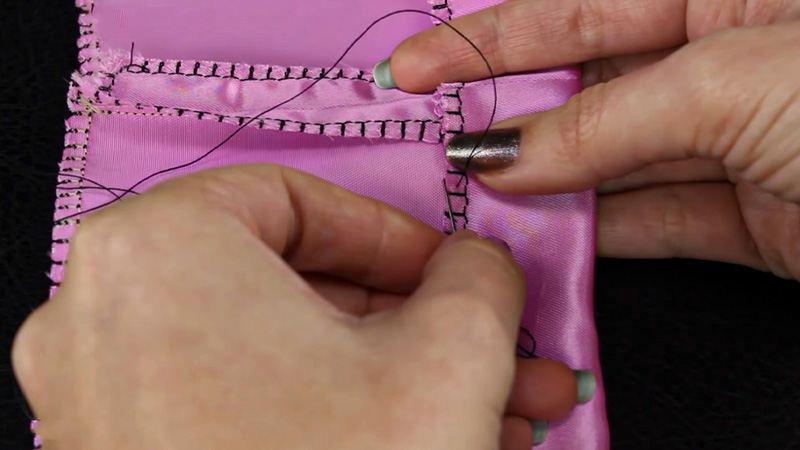
Sewing with silk can be a delightful experience, as this luxurious fabric lends itself well to creating elegant garments and accessories. However, working with silk requires some care and attention due to its delicate nature.
Here are some tips and guidelines on how to sew with silk:
Preparation
Before diving into your silk project, take the time to prepare the fabric thoroughly. Pre-wash your silk gently using a mild detergent or a silk-friendly cleaner if your silk is washable.
Alternatively, steaming the fabric can help remove wrinkles and give it a smooth, pristine appearance.
Always check the care instructions specific to the type of silk you are using, as different varieties may have unique requirements for handling and washing. Proper preparation ensures that your silk is in optimal condition for the sewing process.
Cutting
Precision is critical when cutting silk fabric. Opt for sharp scissors or a rotary cutter to achieve clean, accurate edges. This not only prevents fraying but also contributes to the overall professional appearance of your garment.
When dealing with slippery silk, consider using pattern weights to keep the fabric in place and maintain control during the cutting process. Caring during cutting sets the foundation for a well-crafted and polished result.
Needles and Thread
Choosing the right needle and thread is crucial for sewing silk successfully. Select a fine needle, such as a size 60/8 or 70/10, to avoid leaving visible holes in the delicate fabric.
The needle should be sharp to cut through the silk fibers cleanly. Pair your needle with a high-quality silk or fine polyester thread that complements the fabric.
The right combination of needle and thread ensures smooth stitching without causing damage to the silk.
Seam Finishes
Give careful thought to finishing seams in silk projects. French seams are an excellent choice, as they encase raw edges and provide a clean, polished look from the inside and outside of the garment.
Alternatively, using a serger or an overlocking stitch can prevent fraying and maintain the longevity of the seams.
Focus on creating secure seams without unnecessary bulk, allowing the garment to drape beautifully.
Pinning
Opt for fine silk pins to avoid leaving visible marks on the fabric when working with silk. Pin within the seam allowances or use fabric clips to secure pieces together.
To further prevent potential damage, consider placing tissue paper or silk organza between the pins and the silk.
This extra precaution ensures that your silk remains pristine and free from pin-related marks.
Pressing
Silk’s susceptibility to heat damage makes pressing a critical step in sewing. Use a low heat setting on your iron or, better yet, place a press cloth between the iron and the fabric.
The pressing motion is preferred over ironing to prevent unnecessary stretching of the silk. Always test a scrap piece of silk before pressing your project to avoid unintended consequences.
Interfacing
Opt for lightweight, fusible interfacing specifically designed for delicate fabrics like silk when interfacing is necessary.
Before application, test the interfacing on a scrap of silk to ensure proper adhesion without causing puckering or stiffness.
Careful selection and testing of interfacing contribute to the overall comfort and drape of your silk garment.
Hemming
Achieving a polished hem is essential for the final presentation of your silk creation. Consider using a narrow hem or a hand-rolled hem for a refined finish.
If your sewing machine has a rolled hem foot, take advantage of it to create a neat, even edge. A well-executed hem enhances the overall elegance of your silk garment.
Handling Slippery Silks
Due to their slippery nature, silky fabrics like satin or charmeuse can be challenging. Exercise extra care using tissue paper as a stabilizer during cutting and sewing.
Another helpful technique is using a washable fabric stabilizer spray to add stability and prevent slipping.
These precautions make handling slippery silks more manageable, ensuring greater precision and control throughout the sewing process.
Practice on Scrap Fabric
For those new to sewing with silk, the importance of practice cannot be overstated. Begin by working on a scrap piece of silk to familiarize yourself with the fabric’s behavior and characteristics.
Test various stitches and techniques to understand how silk responds to different settings on your sewing machine.
This practice phase allows you to gain confidence and hone your skills before committing to your project.
Be Patient
Sewing with silk demands a degree of patience and mindfulness. Rushing through the process may lead to mistakes or unintended consequences. Take your time, go slowly, and savor the journey of creating a beautiful, luxurious garment.
The effort invested in patience pays off with a finished product that radiates sophistication and craftsmanship. Enjoy the creative process and relish the opportunity to work with this exquisite fabric.
Is Taffeta Fabric Good?
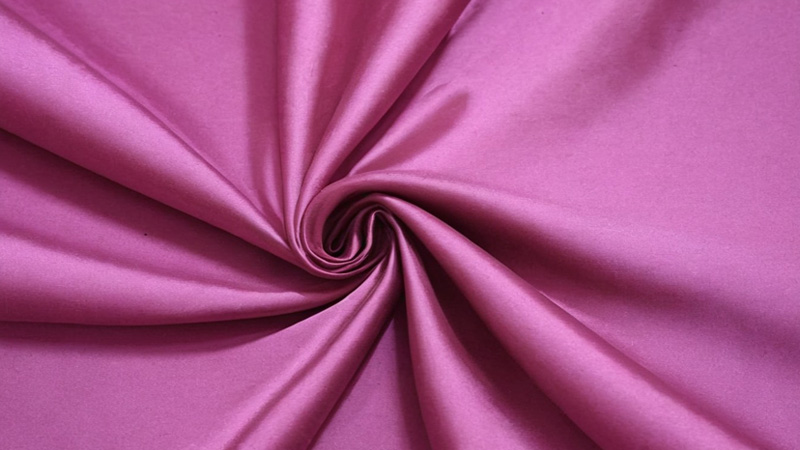
Yes, taffeta fabric is considered to be suitable for its distinct characteristics and versatile applications, making it a popular choice for various garments and projects.
Here are several aspects that highlight why taffeta fabric is considered good:
Elegance and Luster
Taffeta’s reputation for luxurious elegance stems from its glossy surface and inherent sheen. This fabric possesses a distinct luminosity that elevates the overall appearance of garments.
The play of light on taffeta creates a visually captivating effect, making it an ideal choice for formal and special occasion wear.
Whether used in creating sweeping gowns, chic dresses, or sophisticated accessories, taffeta contributes an air of refinement and sophistication to any ensemble.
Its ability to catch and reflect light enhances the wearer’s presence, ensuring a glamorous and polished look.
Structure and Body
One of the standout qualities of taffeta lies in its crisp and smooth texture, which allows it to maintain a well-defined structure.
This structural integrity makes taffeta particularly well-suited for garments that demand volume, such as ballgowns and A-line dresses.
The fabric’s ability to hold shape ensures that dresses flow gracefully and maintain a distinct silhouette.
Taffeta drapes beautifully, creating garments that are visually stunning and have a refined and polished appearance.
Versatility
Taffeta’s versatility makes it a go-to choice for a wide range of garments, from elegant eveningwear to timeless bridal gowns.
Its adaptability allows designers to incorporate taffeta into various styles, making it suitable for classic and contemporary fashion designs.
Taffeta skirts and blouses, for example, can seamlessly transition from formal events to more casual settings, showcasing the fabric’s versatility in different wardrobe pieces and styles.
Durability
Known for its durability, taffeta stands out as a fabric that can withstand the test of time. Its resistance to wrinkles contributes to the longevity of garments made from this material.
Taffeta clothing items maintain their pristine appearance even after multiple wears, ensuring that the investment in a taffeta piece pays off over the long term.
This durability adds a practical dimension to the fabric’s allure, making it a reliable choice for various wardrobe staples.
Color Retention
Taffeta fabric exhibits exceptional color retention, enhancing its visual appeal and making it an ideal canvas for vibrant designs.
The fabric holds colors vividly, allowing designers to create garments that showcase a rich and luscious palette.
This characteristic is particularly advantageous for garments where color plays a pivotal role in the overall design, allowing taffeta to stand out as a vibrant and captivating choice in the fashion industry.
Formal and Bridal Wear
Taffeta’s luxurious qualities make it a preferred formal and bridal wear fabric. Wedding dresses crafted from taffeta are celebrated for their timeless elegance.
The fabric’s ability to capture and reflect light enhances the overall aesthetic, creating a stunning visual effect that complements the grandeur of special occasions.
Taffeta’s presence in upscale fashion is solidified by its role in crafting exquisite bridal gowns and formal attire.
Textural Variety
Taffeta’s availability in various textures, including plain, shot, moiré, and ribbed varieties, adds an extra layer of appeal to the fabric.
This diversity in textures allows designers to choose the type of taffeta that best complements their creative vision.
Whether seeking a smooth and sleek finish or a textured and dimensional look, the varied options in taffeta textures contribute to the uniqueness of each garment, allowing for endless possibilities in design.
Resistance to Stains
Taffeta’s practicality extends to its particular resistance to stains, making it an excellent choice for events where spills and mishaps may occur.
While not entirely stain-proof, the fabric’s composition often allows for easier cleaning and maintenance compared to more delicate materials.
This resilience to stains enhances the wearability of taffeta garments, ensuring that they remain impeccable and ready for various occasions.
Can You Iron Taffeta?
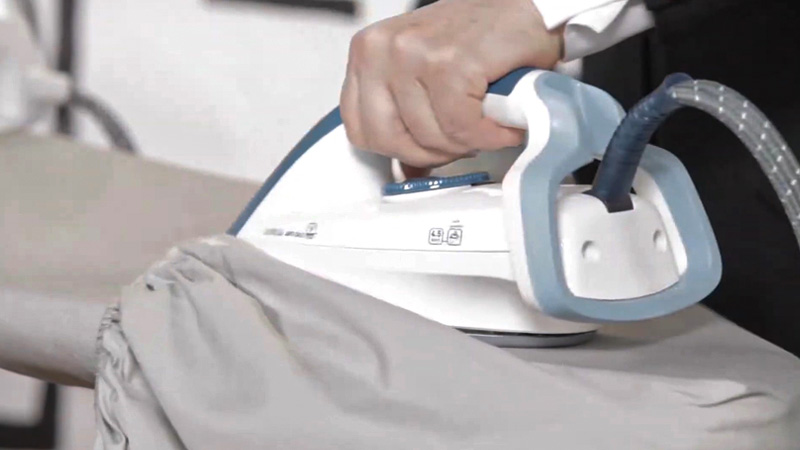
Yes, you can iron taffeta, but it requires a bit of caution and specific care to avoid damaging the fabric. Taffeta is known for its smooth and crisp texture, and ironing can help restore its appearance and eliminate wrinkles.
Here are some tips on how to iron taffeta effectively:
Low Heat Setting
Taffeta, known for its delicate nature, demands careful attention regarding heat application. Selecting a low heat setting on your iron is paramount to prevent potential damage, such as scorching or melting.
Opt for a silk or low-temperature setting to ensure the taffeta fabric remains unharmed during the ironing process.
Taking this precautionary step preserves the integrity of the fabric and maintains its luxurious appearance.
Use a Press Cloth
To avoid unintended consequences, shielding taffeta from direct contact with the iron is essential.
A press cloth, typically a thin cotton or muslin fabric, is a protective barrier between the iron and the taffeta.
This technique prevents direct heat exposure and ensures that the heat is distributed evenly, minimizing the risk of damage. The press cloth is a simple yet effective tool in maintaining the pristine condition of the fabric.
Test on a Scrap Piece
Before subjecting your actual taffeta garment to the heat of the iron, conducting a test on a scrap piece or an inconspicuous area is a prudent step.
This allows you to verify that the chosen heat setting is appropriate for the specific taffeta fabric you are working with.
Testing beforehand helps prevent any adverse effects on the fabric and ensures a smooth ironing process for the entire garment.
Press, Don’t Iron
The technique employed during ironing plays a crucial role in preserving the integrity of taffeta. Instead of traditional ironing, adopt a pressing motion.
Press the iron onto the taffeta rather than gliding it back and forth. This method minimizes the risk of stretching or distorting the fabric, ensuring the taffeta retains its smooth and crisp texture throughout the ironing process.
Avoid Steam or Use with Caution
While some fabrics tolerate steam well, taffeta may not be as forgiving to excessive moisture. Exercise caution when using steam, opting for a low-steam setting if necessary.
Too much steam can lead to water spots or alter the fabric’s texture. Testing the steam function on a small area before applying it to the entire garment ensures that the taffeta reacts positively to the moisture.
Iron from the Wrong Side
Preserving the sheen and texture of taffeta is a priority when ironing. Whenever possible, iron the fabric from the wrong side.
This precautionary measure helps protect the taffeta’s delicate surface, ensuring its luxurious appearance remains unblemished.
If ironing from the right side is unavoidable, using a press cloth becomes even more critical to safeguard the fabric.
Hang to Air Out Wrinkles
An alternative to direct ironing for lightweight or delicate taffeta fabrics involves hanging the garment in a steamy bathroom. The humidity in the air can naturally release wrinkles, providing a gentle solution to garment care.
This method allows the fibers to relax without exposing the fabric to the direct heat of the iron, which is handy for delicate or intricate taffeta designs.
Professional Cleaning for Silk Taffeta
Silk taffeta, being more delicate, may benefit from professional cleaning methods. Following the care instructions provided by the fabric manufacturer is crucial.
In many cases, dry cleaning is recommended to preserve the quality of silk taffeta. This ensures the delicate fibers are treated with care, maintaining the fabric’s luxurious feel and appearance over time.
FAQs
Can I sew casual wear with silk taffeta?
While silk taffeta is often associated with formalwear, it can also be used for casual wear. Consider sewing blouses, skirts, or lightweight jackets to add a touch of sophistication to everyday outfits.
What accessories can I make with silk taffeta?
Silk taffeta is ideal for creating accessories such as scarves, shawls, and clutch purses. Its luxurious feel and glossy finish make these accessories perfect for adding an elegant touch to any ensemble.
Is silk taffeta suitable for home décor projects?
Absolutely. Silk taffeta can be used for luxurious home décor items like curtains, throw pillows, or tablecloths, bringing an element of luxury to your living space.
Can I sew A-line dresses with silk taffeta?
Yes, silk taffeta is an excellent choice for A-line dresses. Its ability to hold its shape and provide a beautiful drape creates flattering silhouettes that showcase the fabric’s sheen and structure.
To Recap
The versatility of silk taffeta opens a realm of creative possibilities in the sewing world. From glamorous evening gowns and ballgowns to sophisticated skirts, blouses, and accessories, this luxurious fabric lends an aura of opulence to various projects.
Whether crafting timeless bridal attire, elevating casual wear, or enhancing home décor, silk taffeta’s smooth texture, crispness, and luminous sheen make it a fabric of choice for those seeking elegance.
Carefully considering sewing techniques, such as French seams and precise pressing, ensures the fabric’s beauty is preserved.
With silk taffeta, every stitch expresses refined craftsmanship and enduring sophistication.
Leave a Reply